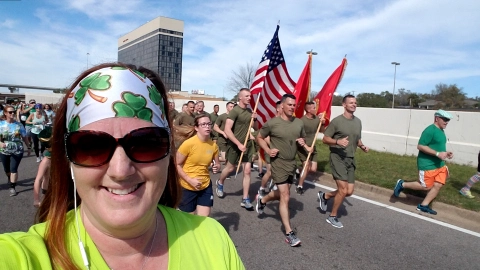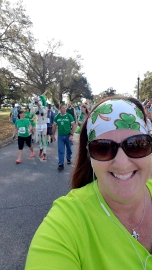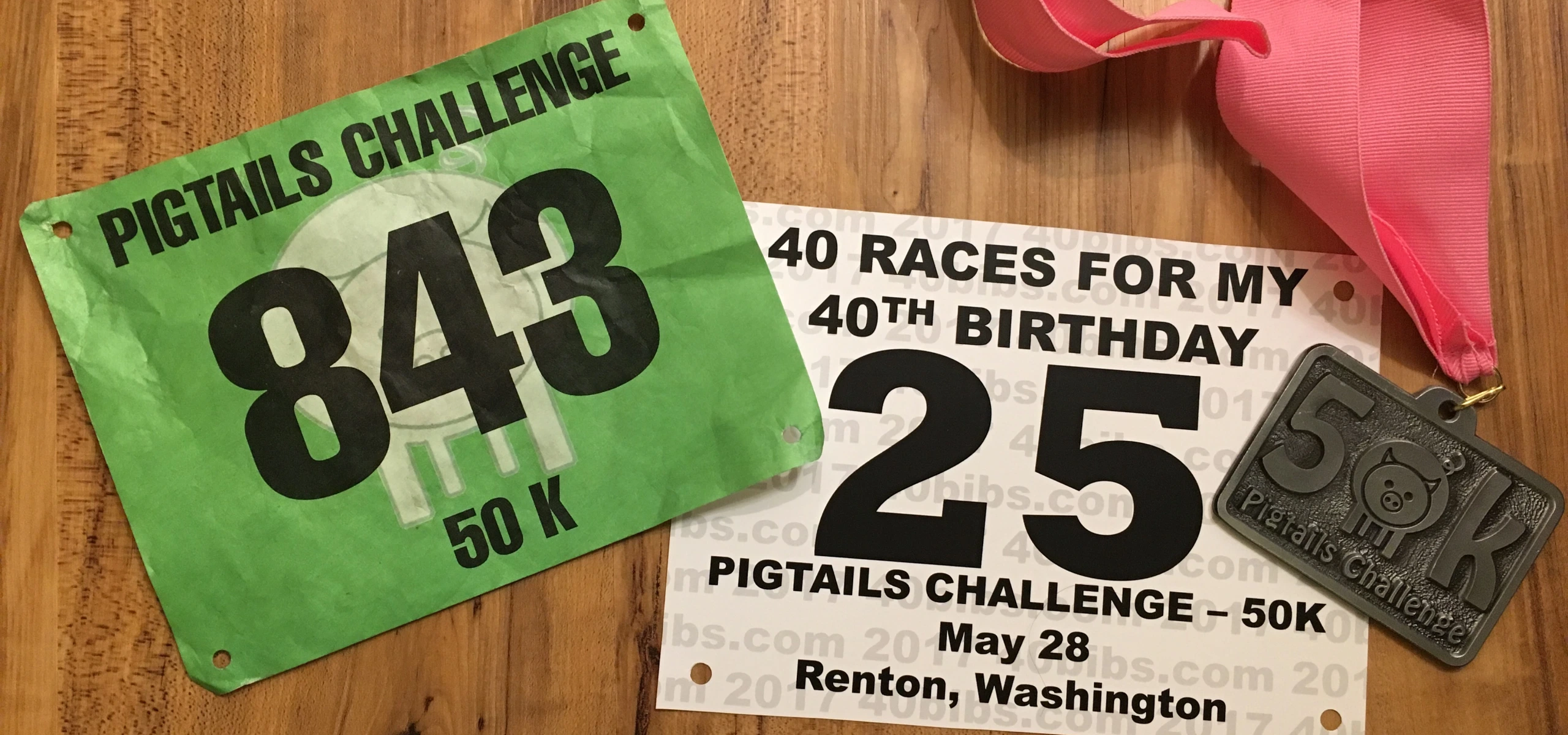

The race was nearly 72 hours old when I joined on Sunday morning.
Like the person who shows up for the end of a team project and then takes credit for the whole thing, I lined up for the Pigtails Challenge 50k start in Renton, 11 miles southeast of Seattle. This race was kind of a lark for me, having registered just four weeks ago from the back of an Uber when my friend, Sporty Diva Rose Coates, put out a call on Facebook. (This is also when I learned that my credit card is on file with ultrasignup, meaning I can 1-click my way to ultra race registrations; a discovery I anticipate may lead to future poor decisions, particularly after wine and smack talk on Twitter).
Four weeks post-81 miles at Badwater Salton Sea, I wasn’t exactly trained for a 50k. I’d taken three weeks “off,” logging slow and easy run/walks of up to 16 miles before commencing with training for the Suncadia Multisport Festival at the beginning of August. I’d replaced the 13 mile “steady long run 10% slower than marathon pace” on day 7 of my training plan with this 50k.
I was here to see the 200 milers.
I’d read about 200 mile races and, quite frankly, they didn’t get the butterflies and pixie dust swirling for me like 100-milers. Still, when I learned the Pigtails Challenge included a 200 mile race, beginning on Thursday morning, 150 miles on Friday, 100 miles and 100k on Saturday, and 50k on Sunday, the prospect of being the fresh-face on a 10-mile loop course with people who’d been running for days was intriguing.

By the time I arrived on Sunday morning, nearly 72 hours into the 200 mile race, there were just two runners left on the course. The temperatures in the previous days were well above average and, in the 80s, downright debilitating by ultra-running standards.
As with many ultras, particularly those without a great deal of scenery, my own race memory is spotty. I remember encountering Joanne at my mile 1.5 — her 98.5 — on her way to being the first female finisher in the 100 mile in 24:44:32. I remember spending two miles run/walking with Mark, a retiree from Alabama and two-time 50 stater, now embarked on a mission to run an ultra in all 50 states. And I remember Karl, the 67 year old 100-mile finisher who, in the final mile of his race and me with 9 to go in mine, leaned in conspiratorially and said, I think you’re the third woman; stay focused.
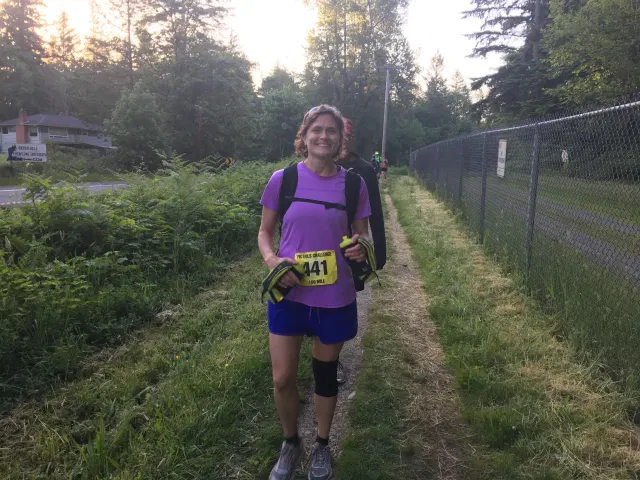
Joanne, the first female 100 mile finisher, all smiles with just 1.5 miles to go.
Did I say this was supposed to be a lark? In shorter races, going out slow for too long can lead to a time deficit that is impossible to close. In ultras, however, going out slow leaves enough in the tank to be moving well when others are breaking down. I passed the second place woman just one mile after being told I was in third. With Karl’s directive to stay focused, I completed my last, 10-mile lap 1 minute per mile faster than I’d completed the first lap, the second woman and fourth overall in the 50k.

Daro, seated, is congratulated by a 150-miler after completing his epic 200 mile run. In the background, one of 16 racers over the four races who dropped, succumbing to the heat.
I watched others finish as I sat in a camp chair, shaded by the aid station tent, and enjoying a veggie burger and a beer. Daro came in at 79:25:03, the second 200 miler and first male finisher. And April who, along with two pacers, stopped into the tent long enough for medical volunteers to cut the compression sleeves off of her calves and stuff bags of ice down her bra and shorts before she departed for her last lap. She would finish in 84:49:44, missing the 82 hour cutoff, but still finishing.

By Sunday morning, April had been moving non-stop since Thursday, logging just 5 hours of sleep during her nearly 85-hour run.
Now the butterflies and pixie dust are swirling.
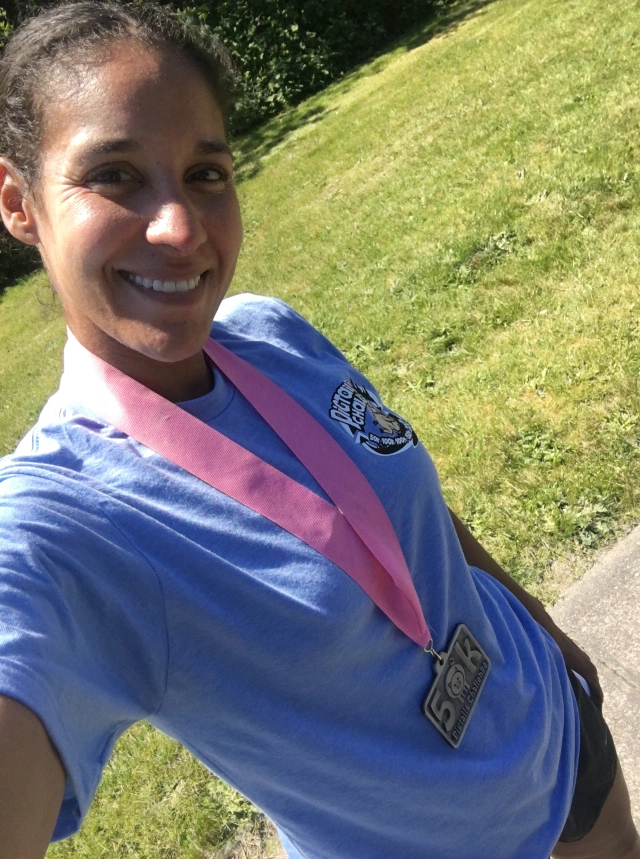
Second woman overall in a field of 14, fourth finisher of 23, and future Pigtails 200 mile competitor.
Ever done a destination race? How about one that will take you so high, you can see three states and Canada from the top? Do you want to?
I’ve received so many messages from people inspired by my quest to run 40 races in 2017 for my 40th birthday, as well as my support for 40 other runners. One of those messages came from the Catamount Trail Association, inviting me to their Race to the Top of Vermont on August 27. As much as I would love to run what has been called “the race most worth traveling for in Vermont,” it is actually my 40th birthday weekend (yay!) and I can’t travel to Vermont (boo!) So we did the next best thing…
I am so excited to partner with CTA to offer 10 bibs for the Race to the Top of Vermont!
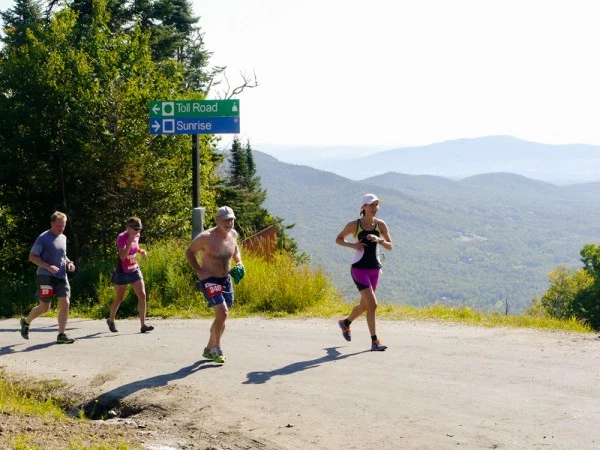
The 4.3 mile course climbs 2,564 vertical feet on the famous Mt. Mansfield Toll Road to the summit parking lot. Along the way, runners will have spectacular views of Smuggler’s Notch and the surrounding Green Mountains, over a steady incline averaging about 11 percent over the length of the course. The reward? A summit finish with one of the most beautiful views in New England overlooking three states and Canada. Check out the race video!
Sound like an amazing challenge? The CTA and I would love to make it a reality! If you would like to participate in the Race to the Top of Vermont, please contact me, and let me know you’d like to participate in this amazing experience.
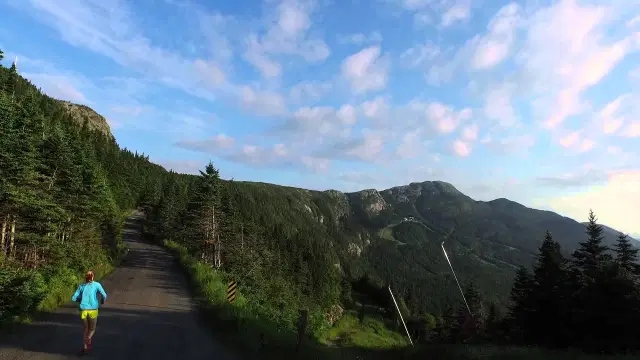
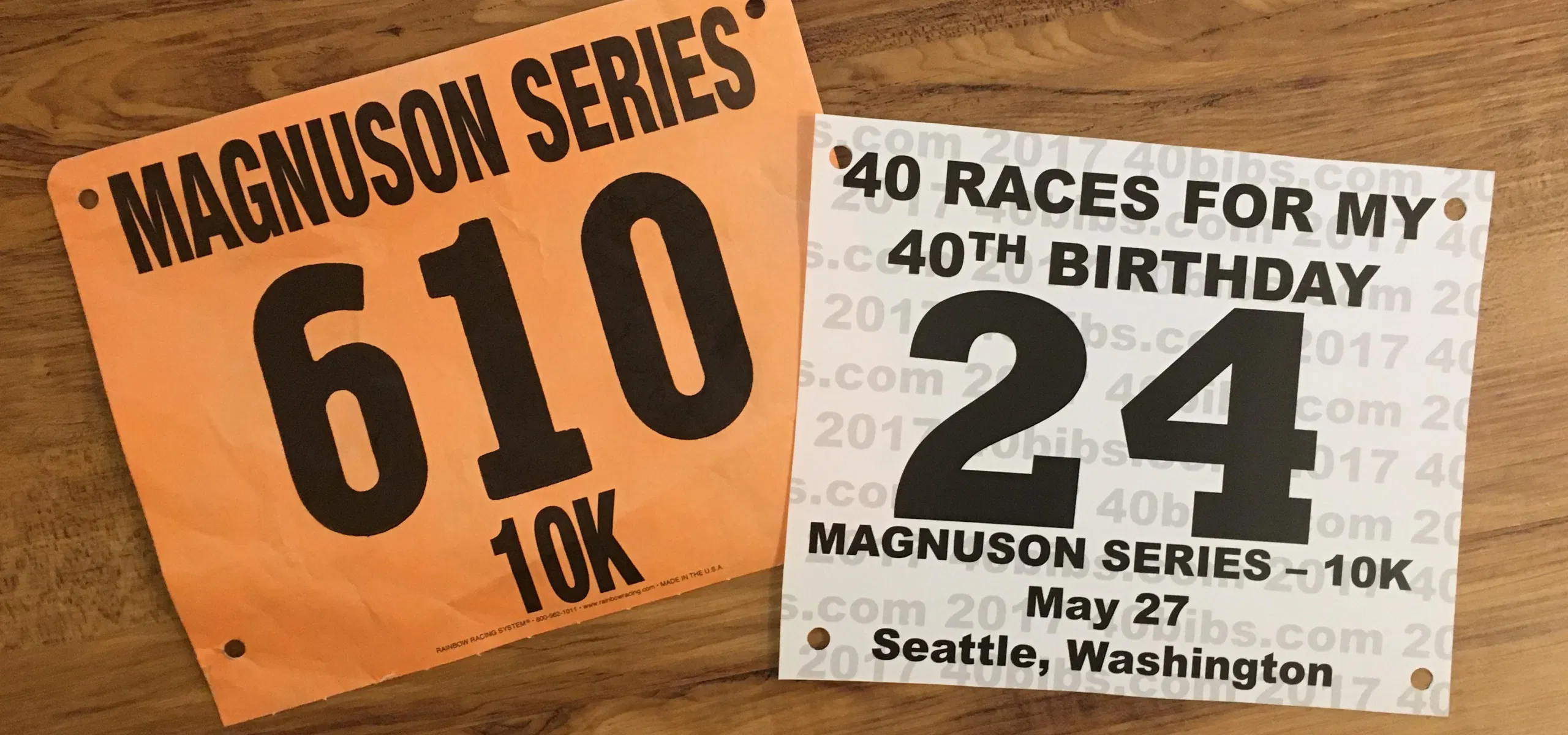
Sharon gets into the car, black technical race t-shirt, leggings and neon Asics, holding her iPhone armband in her hand. She reminds me of a younger version of me, had I been a runner when I was her age.
“Good morning,” she says. Her Indian accent sounds like chimes.
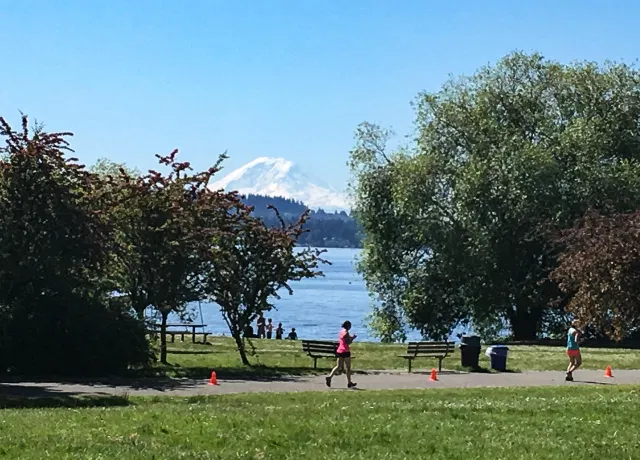
Racers enter the final stretch of the 3.1 mile loop course, Mount Rainier towering in the background.
In the drive from the Marriott to Magnuson Park, I point out the University of Washington and Mount Rainier. I describe the race course. She tells me about the 10ks she and her boyfriend run in Bangalore, where she works for Tanya who works for Bindu who works for Nancy who works for me.
It doesn’t occur to me until we near the 1 mile marker that she has no idea how far one mile is, and I explain the 10k course we are running is 6.2 miles long. My explanation is complicated, as this is a 5k-10k-15k loop course with mile markers in bunches of three: 7-4-1; 8-5-2; 9-6-3. We settle on the fact that the 10k is two loops.
We drink water and eat bananas after we cross the finish line, commenting on the unseasonable heat.
“Would you take our picture?” I ask a spectator standing near the finisher banner. “With my phone too?” Sharon asks.
We pose together. Me, on race #24 in my quest to run 40 races this year. And Sharon, in her first trip to the United States. Racing with me was on her “to do.” Not for the first time during this challenge, I am humbled.
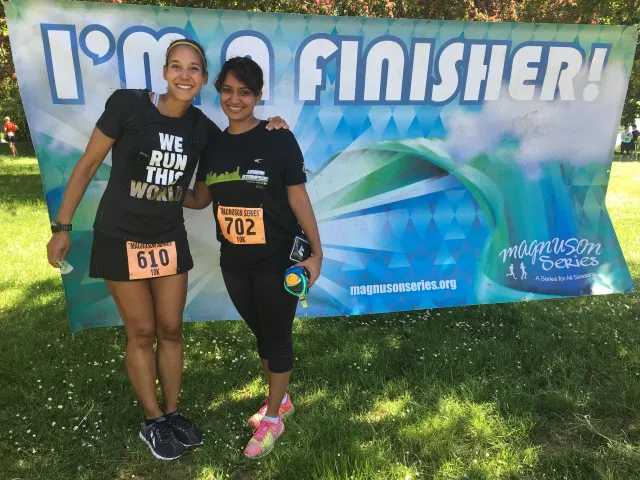

I tipped my red Altra trail sneakers over the toilet bowl, watching small rocks and sand particles float to the bottom and settle on the white porcelain. This was sand from another time and another place; the Anza-Borrego Desert California Riding and Hiking Trail, an 8-mile single track rising 4,000 feet, which I’d climbed in miles 40 through 48 of the Badwater Salton Sea 13 days ago. I’d not run more than two miles since then. I was afraid I’d forgotten how.
Silly, but a fear nonetheless. In the days following Badwater, I’d done what I always do post long ultra. I spent several vacation days in Los Angeles, spending hours each morning walking the Griffith Park trails. Back in Seattle, I ran/walked along the Lake Union sidewalks for a fraction of my typical training run distance.
I took to the start line of the Cougar Mountain Trail Series 10.8 mile run this morning with metaphorical cold feet, turning literal when, within the first quarter-mile, I was soaked through to my socks, the trail grasses wearing days of rain. By the two mile mark I’d settled into a pace and a group of runners with whom I would stay in proximity for the entirety of the race.
And when I was done, the fine yellow dust of the Anza-Borrego desert was gone from my sneakers, replaced with the thick, brownie-batter mud of Washington trails in the springtime. Turns out my body has a good memory.
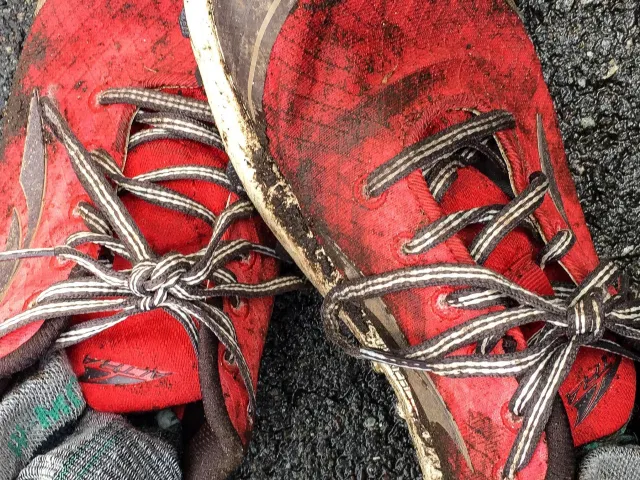
It was nearly 10:30pm when the Uber dropped my brother off at his Hollywood home and continued the additional three-and-a-half miles to the Airbnb I was renting in Los Feliz during my visit. I scrolled Twitter for the first time in several hours, landing on Nike’s live Breaking2 broadcast, 90 minutes in progress.
With five million worldwide, I spent the next 30 minutes watching elite Ethiopian runner, Eliud Kipchoge, attempt to break the two-hour marathon barrier.
I followed the quest to break two hours for the better part of 2017, ever since running the Standard Chartered Dubai Marathon in January, alongside (or, more accurately, over two hours behind) Kenenisa Bekele, as he attempted to break the marathon world record set by Kenya’s Dennis Kimetto in the 2014 Berlin Marathon (2:02:57). After a nasty fall within seconds of the start line, Bekele would drop from Dubai just after the half way point.

Bekele and the lead pack, seemingly running on air near Mile 6 of the Standard Chartered Dubai Marathon on January 20, Race #7 in my quest to run 40 races in 2017.
Nike’s Breaking2 has received a fair amount of flack. One part moonshot, one part masterful marketing campaign, the company controlled for everything including (but not limited to) the three athletes chosen to make the attempt, the weather, the course, the pacers and the gear. In fact, Kipchoge’s finishing time would not even count against Kimetto’s world record, as the run violated International Association of Athletics Federations (IAAF) rules, including having runners’ fluids shuttled to them on the course via motorcycle (so they wouldn’t have to divert energy to a drink table, as in a typical marathon), as well as the highly practiced inverted diamond pacer formation (to lessen wind resistance) and rotating pacers (to ensure the pacers’ continued speed). In short, the attempt was highly engineered.
But should that matter?
One of the best parts of my job as a Director at Amazon.com is helping others think about their career trajectories, and where they hope to be in months or years, whether in or outside of Amazon. We talk about building intentional relationships with their managers’ managers. We talk about networking, in detail that involves specified lists of people to meet, how to meet them in a way that feels authentic, and what to talk about once they’ve done so. We talk about milestones and timelines and measuring success. Inherent in these discussions, of course, is the assumption of strong performance; for many at Amazon, that comes naturally. But beyond just doing good work and hoping someone will take notice, I am helping them to think about their careers in very deliberate ways. In short, I am asking them to identify their dreams, and then helping them engineer the path to get there.
I’ve had practice. Nearly 20 years post-undergrad, I’ve had four careers. Not four jobs, four careers. My most recent pivot was in 2016 when, after nearly a decade in labor relations and nearly five years in Amazon’s warehouse fulfillment organization, I announced to my manager that I wanted a new job outside of labor relations and outside of warehouse fulfillment. In other words, I told him I wanted a job for which I was minimally qualified.
Over the course of six months, I explored my passions within the company through informal discussions and a lot of cups of coffee with leaders of various departments, I got real about my strengths and my areas of opportunity, and I landed in a role that has helped me grow exponentially. I feel like I am much more valuable to the Company, and to other employers, after making the move. But I’m only 39, and I have a lot of good working years left in me. So I continue to engineer.
The best kind of dreams don’t come true over night. They don’t come true on their own, and they don’t come true without planning and intention.
In the final minutes of Kipchoge’s epic run, it became clear he was unlikely to break two hours. It didn’t lessen the magic, however. In those final minutes, we weren’t focused on pacers or high tech shoes, we were focused on Kipchoge, and the dream he represented. His 2:00:25 finish, while not officially recognized by any governing body, is an example of the things that can be accomplished by dreaming big, and being unafraid to engineer a path to that dream. What will your path be?
“Passion is a choice. You need to choose to be great. It’s not a chance, it’s a choice.” – Eliud Kipchoge
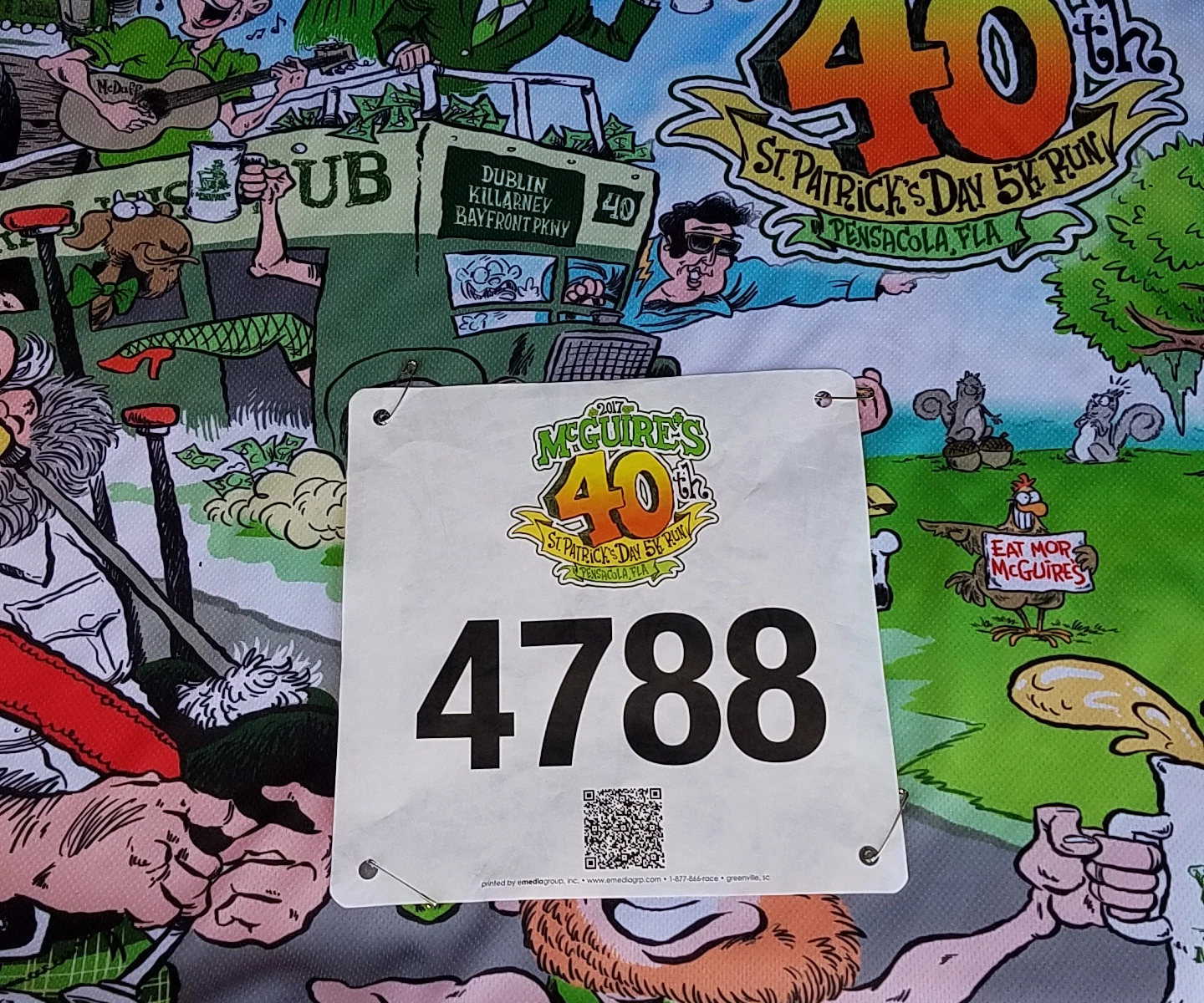
I’m a little over half way done with my journey to run 40 races this year for my 40th birthday and, up until this point, was very focused on my two longest races of the year, the Black Canyon 100k and the Badwater Salton Sea. In preparing for those events, I was racing nearly every weekend, sometimes twice.
At the same time, however, runners I’ve been sponsoring have been tearing up the road and trails all over the United States, and I’m really excited to bring you more of their stories.
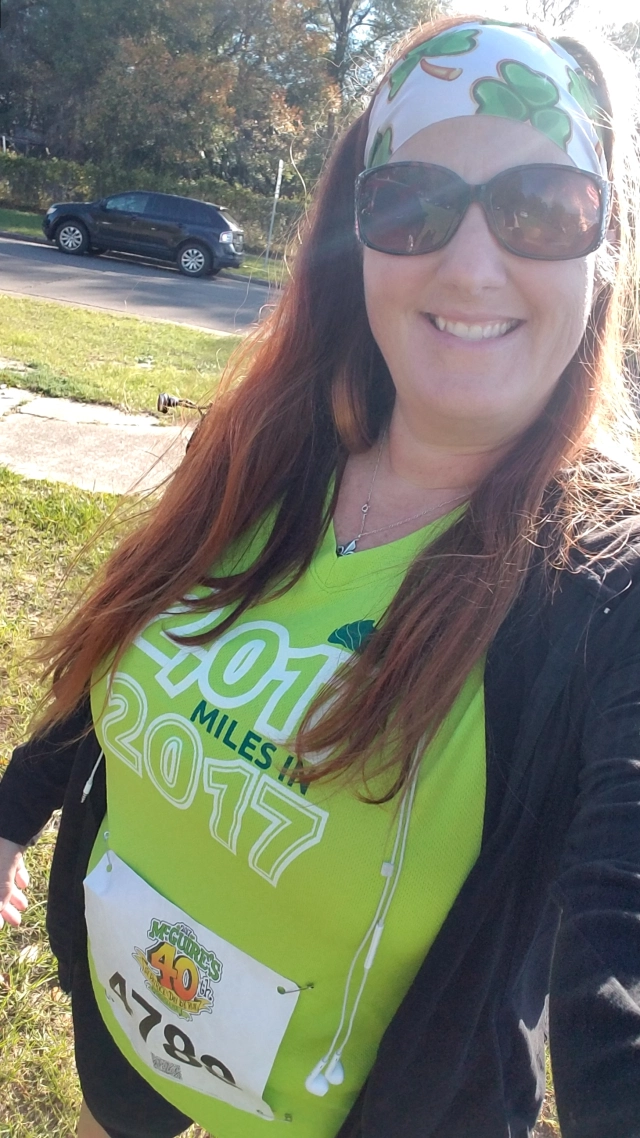
One such runner is Michele who, on March 11, completed her fifth consecutive McGuire’s St. Patrick’s Day Prediction Run in Pensacola, Florida. With a prediction run, you “predict” what you think your finish time will be, and then see how close you can get. But, if that sounds like it makes for a very serious group of runners, you need to check out Michele’s photos. Congratulations on a great run, Michele!

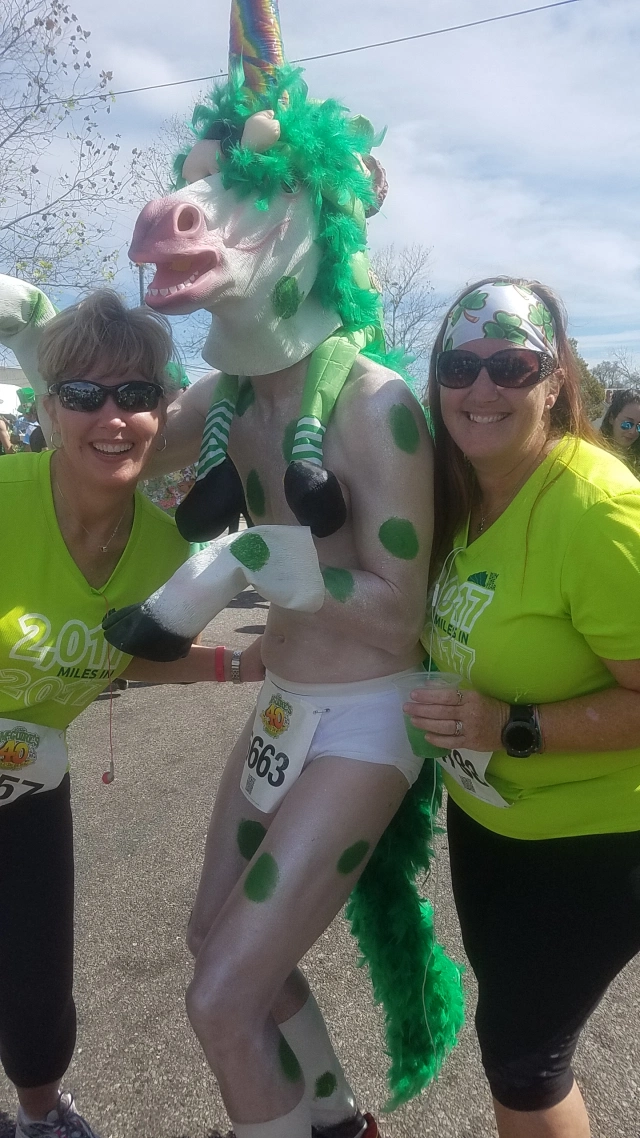
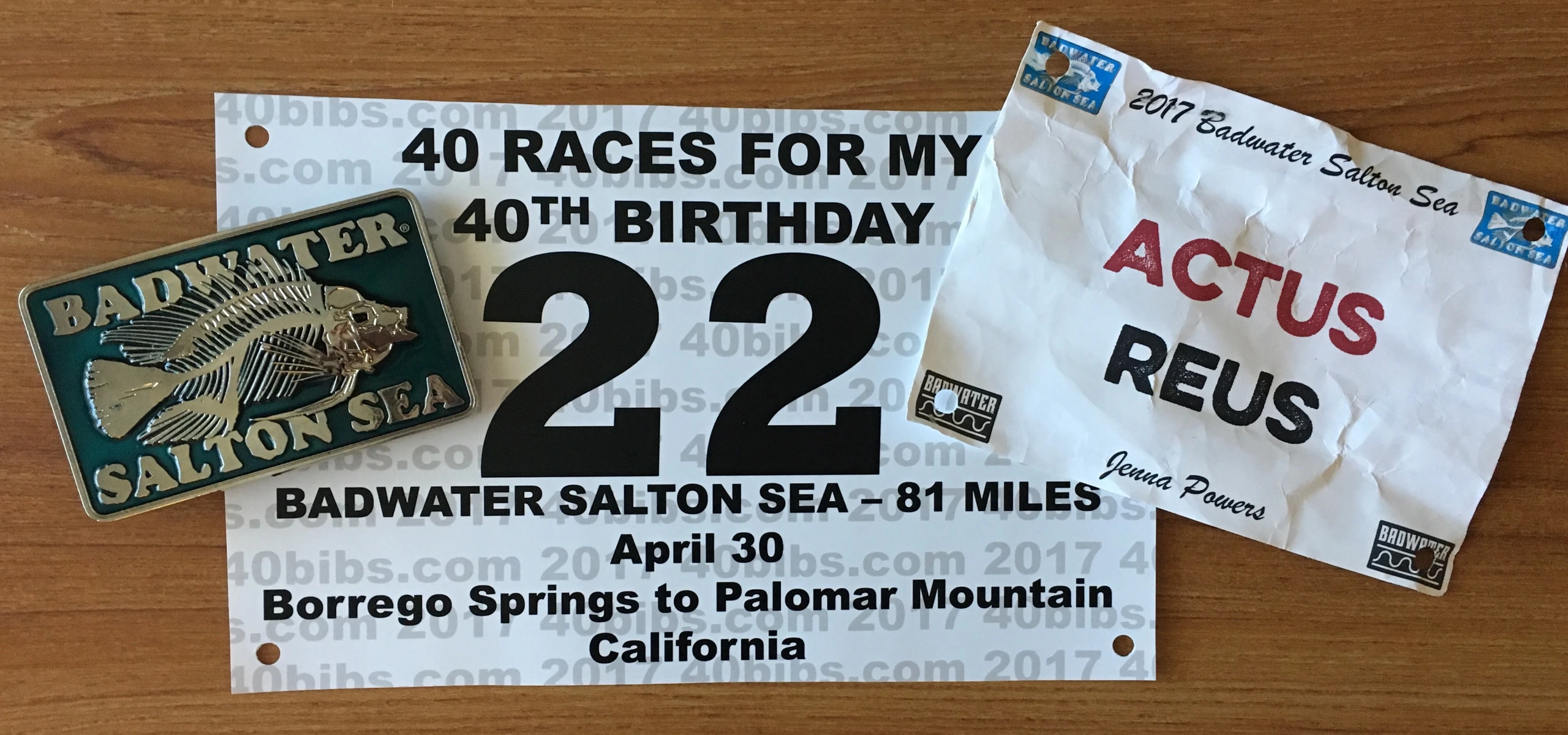
This is a story where I discover I’m consumed by a drive to do my personal best to the exclusion of everyone and everything else. And if that sounds like a positive trait, then I haven’t begun the story correctly.
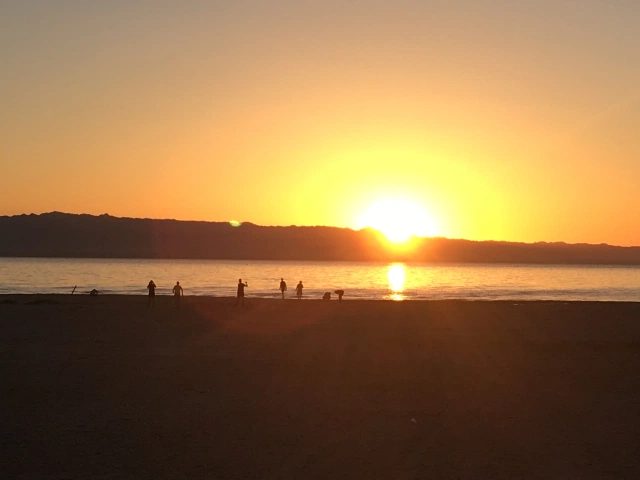
Sunrise over the Salton Sea on race morning.
“This is not about you,” Race Director, Chris Kostman, told the room full of racers and their crews during Saturday afternoon’s pre-race briefing. Designed to allow the greatest number of runners to experience the Salton Sea, Anza-Borrego Desert and Palomar Mountain areas of rural San Diego County with the smallest amount of impact to the landscape, the Badwater Salton Sea is a team event, wherein teams of two and three racers supported by a single crew car leapfrog their way through the 81-mile course. Unlike a relay, where racers “hand off” to one another throughout the day, Salton Sea requires runners to complete the entire 81-miles together.
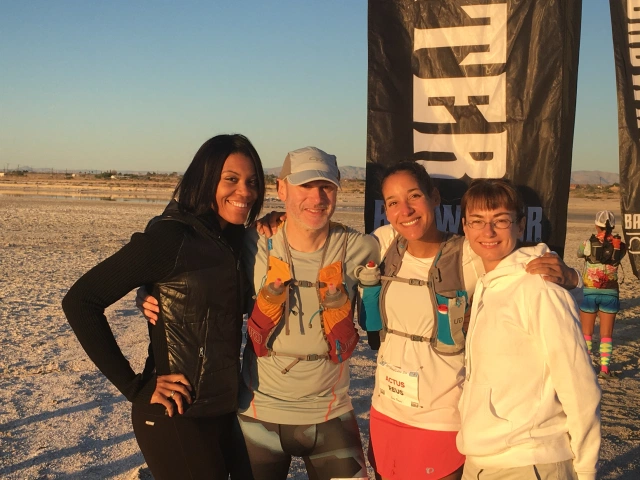
Cierra, Robert, Lisa and I at the start. Cierra and Lisa would crew for us through the day and night.
I began to worry about my partner, Robert, around the 25-mile mark, just over a quarter of the way into the race. The sun continued to climb in the sky and it was taking its toll. We were stopping more frequently for water, and despite my (likely not particularly helpful) needling, these stops weren’t quick. For runners like Robert and I in the middle of the pack, stacking up minutes at the aid stations (or, in this case, at the car serving as our portable aid station), can be the difference between missing a cut-off later in the race or being allowed to continue. And, quite frankly, Robert just looked bad to me. And sounded bad. All signs that did not bode well less than five hours into a what was likely to be a 24-hour day.
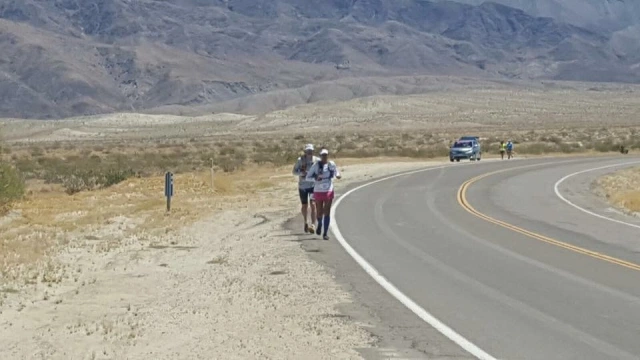
Cierra snaps a photo of Robert and I approaching the car for water in the early part of the race.
Time Station #4, the California Riding and Hiking Trail trailhead at Mile 40, was my sole focus of the daytime portion of the race. The hiking trail would feature the toughest terrain, a nearly 4,000 foot climb over eight miles at the hottest part of the day. And, if begun too late, much of the climb would occur in the darkness.
The time goals I had mapped for us put as at the trail at 2:50pm on the early side, and 4:30pm on the late side. “I think we can make it to the trailhead by 2:00,” Robert said, as we neared the 35-mile mark, walking. Without a watch, he had no way of knowing the actual time. “Doubtful,” I said. “It’s 1:45.”
I arrived at the trail head, Mile 40.5, several minutes in front of Robert, violating race rules requiring we stay within 25 meters of one another. In truth, I’d been violating the rule for the better part of 10 miles. Race rules required that we be on the trail no later than 5:30pm or be pulled from the race. I hadn’t trusted, between the slowing pace and continued stops, that we’d get there in time. Instead of discussing this with Robert, however, I’d just walked faster.
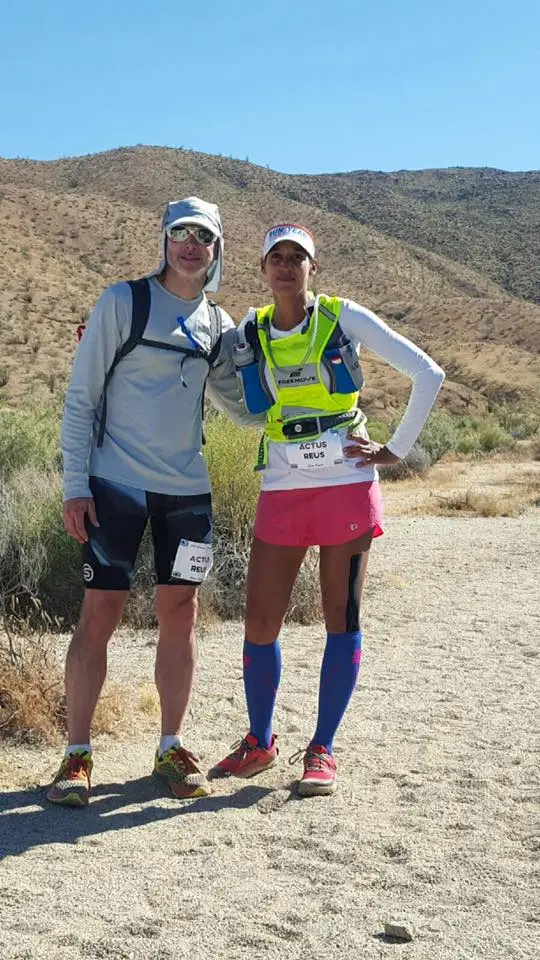
Robert and I at the California Riding & Hiking Trail head.
Robert and I stepped onto the trail together at 4:20pm, later than we’d both wanted, and disheartened by the thought of completing what we’d estimated to be a 4-hour hike in the dark. And, for the first time all race, I too felt I just wanted to throw up and take a nap (in that order). According to our crew, the car thermometer read 97 degrees.
We stopped and sat three times in the first half mile, a climb that takes racers nearly straight up, overlooking the parking lot where we could see the other teams filtering into the time station and beginning their climbs towards us. I looked at my watch, and suddenly had visions of this 4-hour journey taking six hours our eight hours, in the dark and in the cold without enough food and water, because we’d only packed for four. We got up to move a little further up the trail, every other team still on the course now surrounding us. A minute went by, and I turned around. Robert was gone.
We’d settled on the team name, Actus Reus, because we’d wanted something cheeky that gave a nod to both physical activity and the law degrees we both possessed. It is the latin term for “guilty act” which, when proved beyond a reasonable doubt in combination with the mens rea, “guilty mind,” produces criminal liability. It was ironic; because when Robert disappeared from behind me, quite obviously having stopped in the last 60 seconds to sit again, I didn’t go back to get him.

After a near 100-degree day, the sun begins to set on the trail.
I don’t have good answers for this; only the rationalizations I made for myself in the moment and over the nearly six hours before I saw him again. I stayed put where I was. There were people all over the trail. I walked again slowly. I waited some more.
I emerged from the trail four hours after I’d gone in, nearly to the minute, and climbed into the back of our waiting crew car to change into my night time clothes. Forty-five minutes later, carrying two hours’ worth of food and water and without a sign of Robert, I got back on the course. “You have to make a right turn five and a half miles down the road,” my friend and crew member, Lisa, told me. “Call me when you get there so I know you’re okay.” I nodded. “I’ll be okay,” I said, knowing Lisa needed to stay with the car and wait for Robert. “If I run out of water, I’ll get some from another crew.” It was 9:00pm.
Miles 48.5, the end of the trail, through 68, are virtually all downhill; technically the easiest part of the course, if you ignore the fact that runners have now been on their feet for nearly 15 hours. I’d taken off running, and made it a mile a half before Lisa caught up with me in the car. “You need to come back,” she said. “They’re going to disqualify you.”
To many, crewing sounds like the easy part of a race. After all, the runners are running it; crew members just drive around in the car. But crewing is much more than that. It involves long, arduous hours of captivity to runners’ needs. Lisa did not only that for me, be she acted as my advocate when I wasn’t there to advocate (and, likely didn’t deserve to advocate) for myself. I made the mile and a half trek, now uphill, back to the trail, where two gracious race officials, bundled to their cheeks in winter hats and hoods against the now dropping temperatures at the top of the trail, explained to me what they never should have had to: “You have to stay together, or we will disqualify you.”
Robert and I, now together again 15 hours and 20 minutes into the race, walked what felt to me to be very slowly. “How do you feel?” I asked him. Just okay. “Do you think you can go any faster?” No.
Ninety minutes went by. In the distance, the now-familiar tail lights of our crew car, blinking in the night time, stopped just before the right-hand turn. We’d walked five miles. I turned to Robert and had the conversation I should have had with him seven hours earlier on the trail. “I don’t think we can do this.” In response, he did for me what I was incapable of doing for him: he gave me the opportunity to finish.
At Mile 55, 11:20pm, the crew made the call to the finish line at the top of Palomar Mountain. Robert was officially dropping out which, according to the rules, meant I could continue on my own. I crossed the finish line at 5:40am, 23 hours, 19 minutes and 20 seconds after starting. Lisa was beside me, Cierra, asleep in the car, and Robert sitting on the couch eating noodles. If anyone cheered, I don’t recall it.
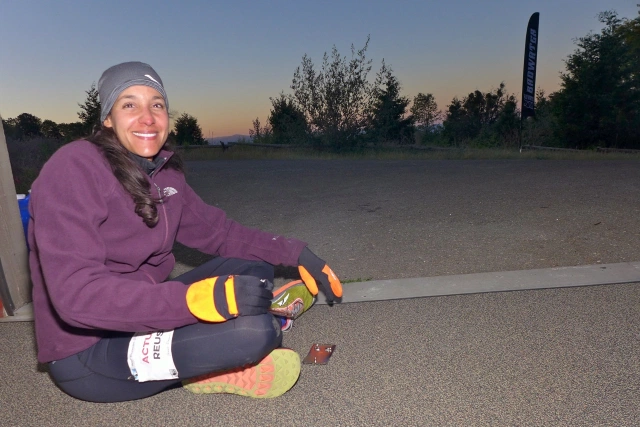
Finished, and after the requisite (and staged) finish line photos by myself and with the team, the Race Director snaps this one of me sitting for the first time in nearly 24-hours.
Robert and I disagree about whether we could have finished within the 28-hour cut-off. At the time he dropped out, we were minutes ahead of two other teams, both of whom would go on to finish in just under 26 hours. He’d spent the entirety of the trail portion with one of the teams. From my vantage point, he’d been struggling for nearly the entire race, and would only continue to get slower as time wore on and we were faced with 5,000 feet of climb in the last 12 miles.
It doesn’t matter who is right. My actions were wrong.
Robert plans to come back next year and finish the race. It’s not likely to be with me. For all the ways I’ve written that being a distance runner makes me a better person, this event brought out the worst in me. And for all the people I’ve had to make right with over the last two days: Lisa, Cierra, race officials, Race Director Chris Kostman, and, of course, Robert, I at least owe it to them to figure out why. While the experience is still fresh, I think it has something to do with having certain standards for myself and being unwilling to compromise on them. And, if you think that an inherently positive trait, I’ve not told this story correctly. As Chris quite plainly put it on Saturday afternoon, “this is not about you.”
The post script is this: Robert, Cierra and I are still friends. Lisa and I are still friends. And I don’t think Chris Kostman hates me, though he will probably create a new, written rule for next year’s race outright prohibiting “unofficial” mid-race separation. I appreciate their willingness to forgive.
The true epilogue will come later. I’m 110 days away from my 40th birthday. I have 18 more races to go this year, and hundreds more training miles. And I’ll use them all to just try and be a little bit of a better runner and a better person than I was before. At base, this is what 40bibs is all about.
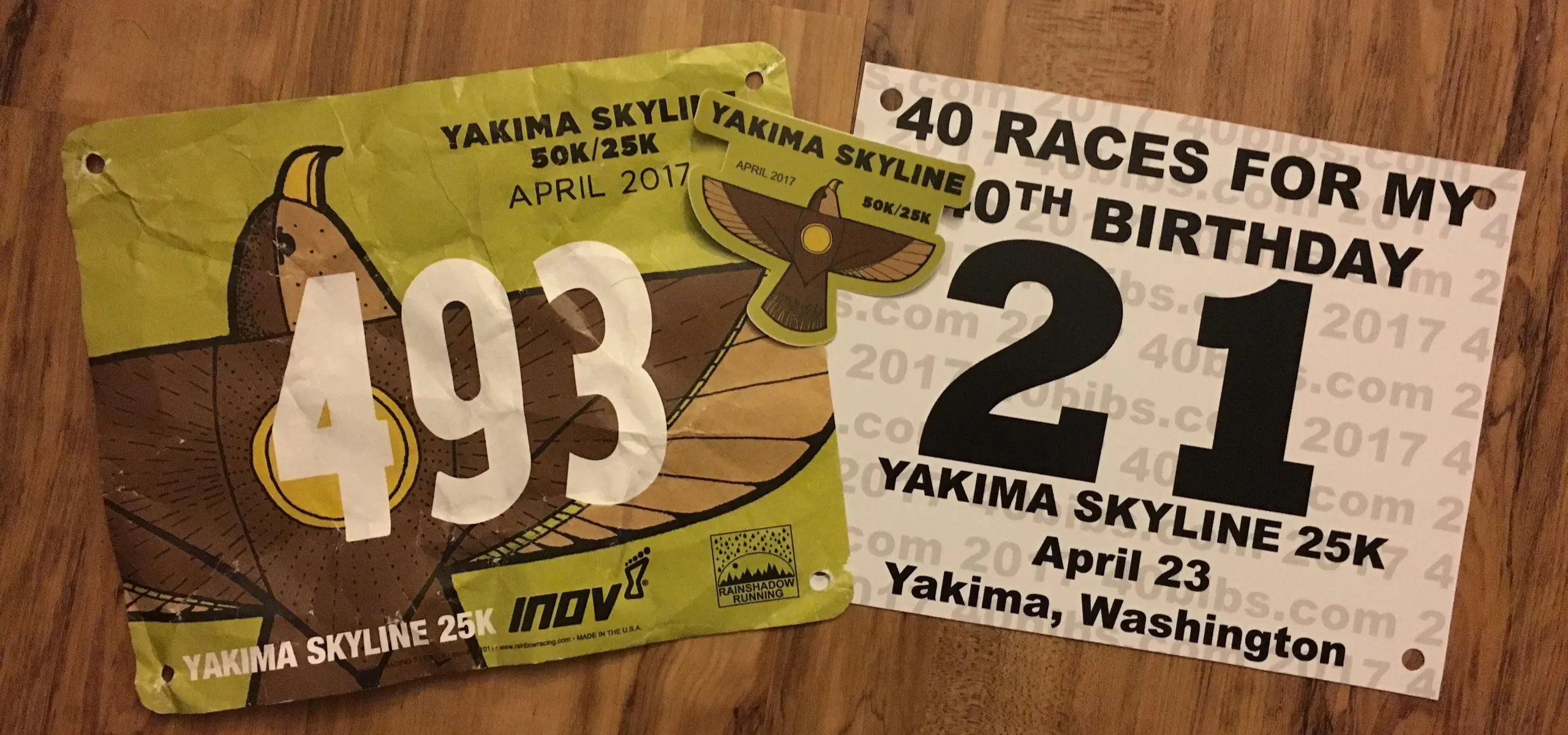
The last thing she does before turning in is pull all the sheets out from under the mattress into a pile in the middle of the bed. I look down at my own sheets, tucked tightly around the queen frame, just how I like them. You learn things when you share a hotel room with someone you’ve only ever spent a couple of days with. But runner days are like dog years; normal people time, multiplied by intensity.

Nicole, Lori, me and Beth. The GirlSquad pre-race.
Unlike road races, trail races breed camaraderie. Words of encouragement for fellow runners, whether they are passing you or the other way around, are expected. And it’s not uncommon for runners to stumble upon one another mid-race and, after hours of solo miles, decide to run together until one of you gets tired and wants to slow down, or the other decides to speed up.
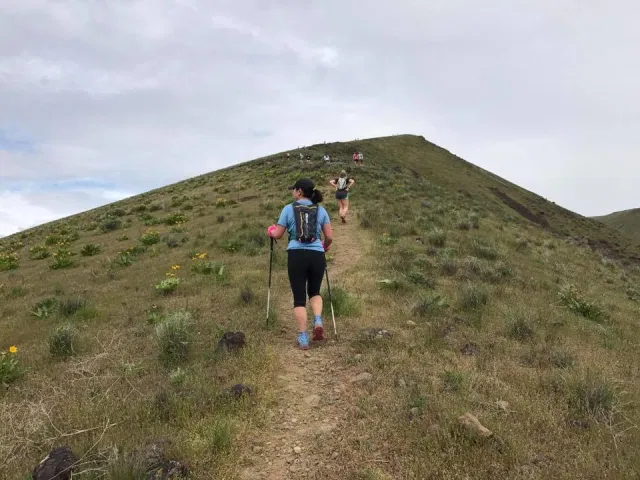
Racers making their way along the Yakima Skyline Rim, more than 4500 feet of gain over 25 kilometers.
Facilitated by social media, Nicole and I formed a friendship that day. One that has grown through Nicole’s first 50k last summer, a half marathon plus training run (when we decided to finish the race and run a few extra miles), a handful of training hikes, and Sunday’s Yakima Skyline 25k. Her runner friends have become my runner friends.

Nicole and I pause from our climb for a quick selfie.
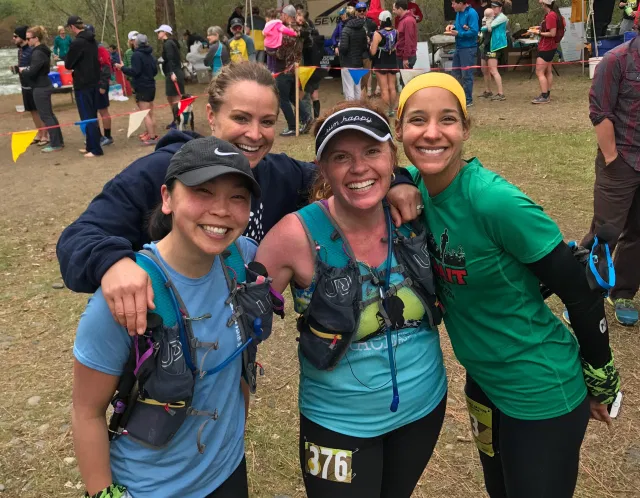
Big smiles at the finish line. For Lori, a fourth place age group finish, while Beth completed her longest ever race. We all celebrate.
This is what runner friends do, and I am grateful.
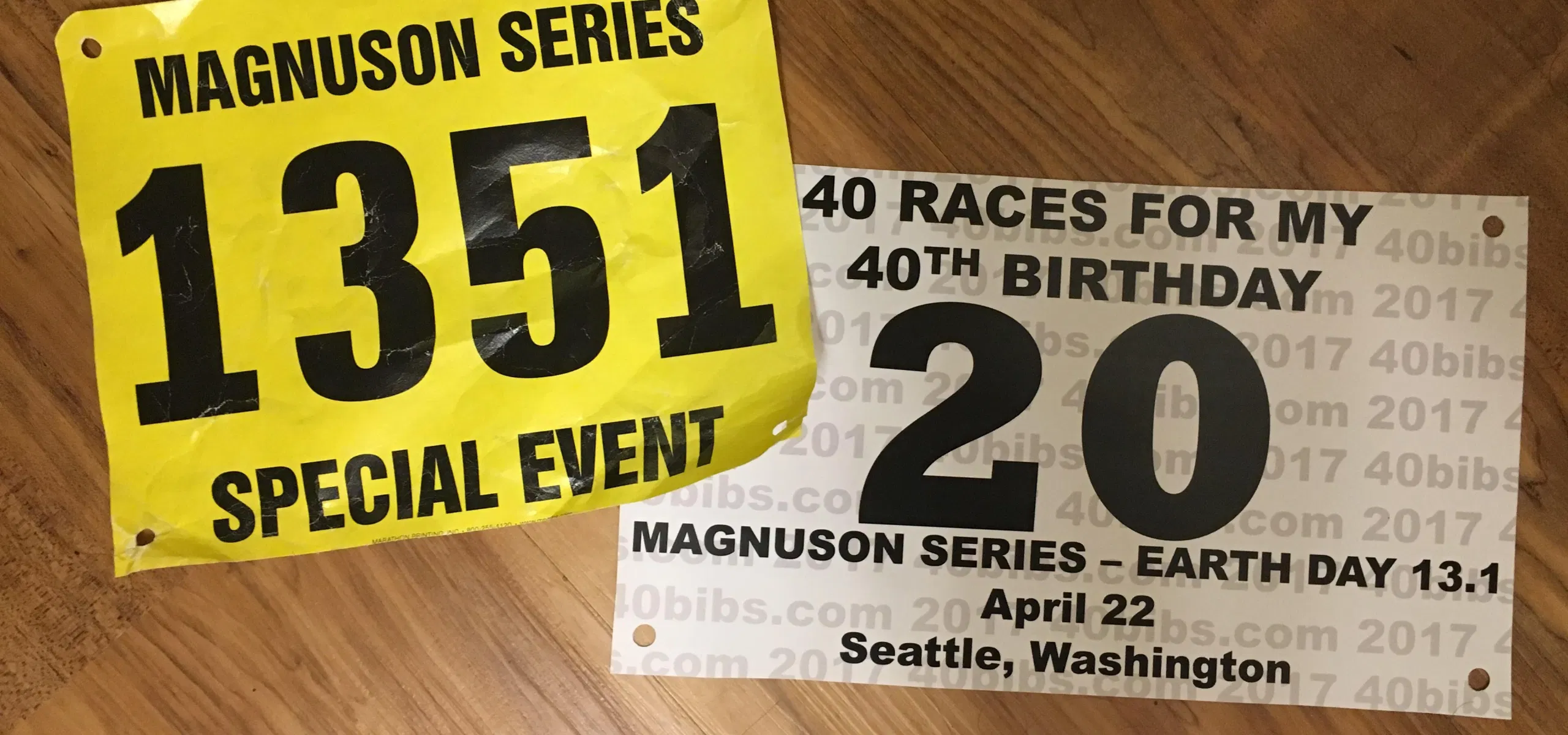
This blog was born in the waning days of 2016. I landed on the goal of collecting 40 race bibs quite easily — I’m going to be 40 in 2017. I gave myself the to the end of the year to achieve my goal, however, as my 40th birthday actually falls in Week 34 of the calendar. Running more than one race per week seemed unreasonable.
But here I am, just 16 weeks into the year and I’ve made it to the half way point. It seems like a good opportunity to reflect on the first half of this journey.
- Total Races: 20
- Total Miles (including training miles): 722
- Total Racing Miles: 369.4
- 5ks: 1
- 10ks: 2
- 15ks: 2
- Half Marathons: 7
- Marathons: 5
- 50ks: 1
- 100ks: 1
- Other Distances: 19.6 mile
And the memories:
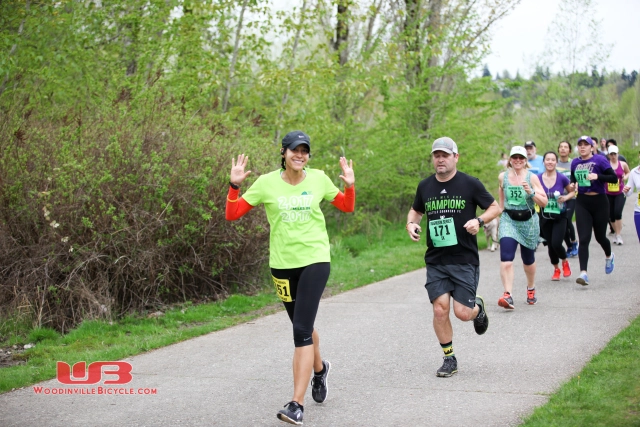
Most Recent Race: Bib #20 – the Magnuson Park Earth Day 5k, 10k, 15k and Half Marathon. My yellow bib identifies me as a half marathoner, leading a pack of 5kers with their green bibs around the first of 4+ 3.1mile laps at Magnuson Park in Seattle.
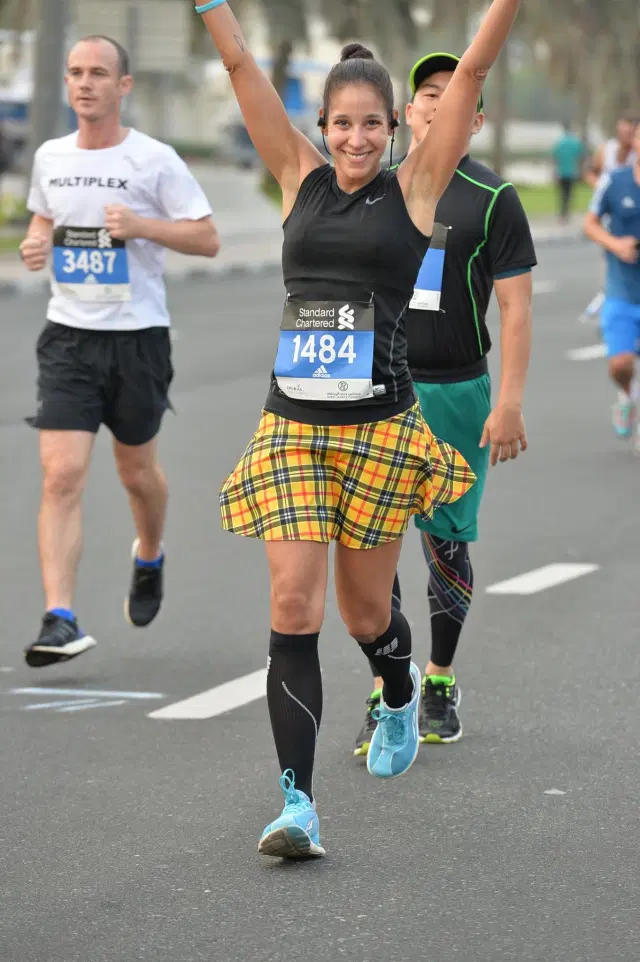
Farthest From Home: Bib #7 – The Standard Chartered Dubai Marathon – 7,403 miles from my Seattle home.
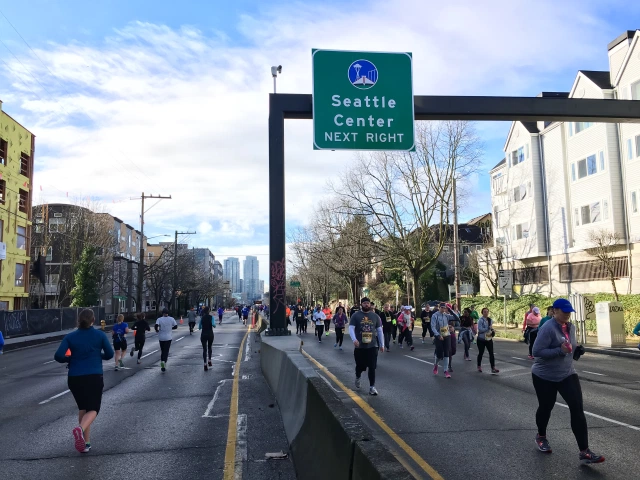
Closest to Home: Bib #13 – Seattle Hot Chocolate 15k – Just 1.5 miles from my front door to the start line, I traveled to the race on foot both ways.
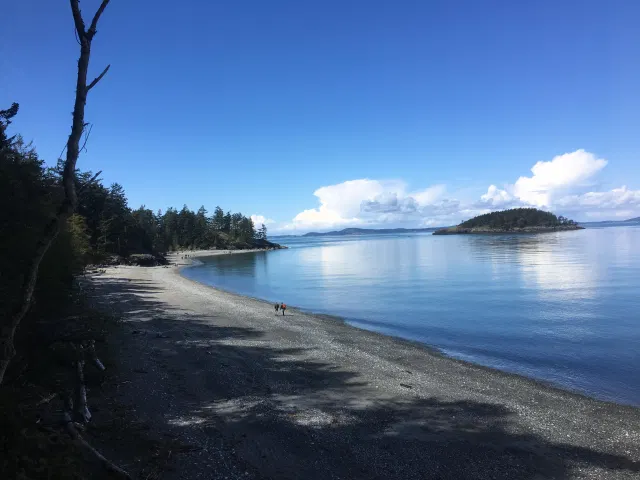
Closest To Nirvana: Bib #19 – The Deception Pass Half Marathon in Oak Harbor, Washington. After days and days of rain, racers were blessed by blue skies and 55 degree temperatures.

Closest to Death: Bib #12 – Black Canyon 100k – Rain pelted racers for nearly the entirety of the 62 mile race, the conditions turning particularly brutal after dark. I was treated for hypothermia and hypoxemia (low blood oxygen) post-race, but still managed a time good enough to qualify for the Western States 100 lottery, my sole reason for running.
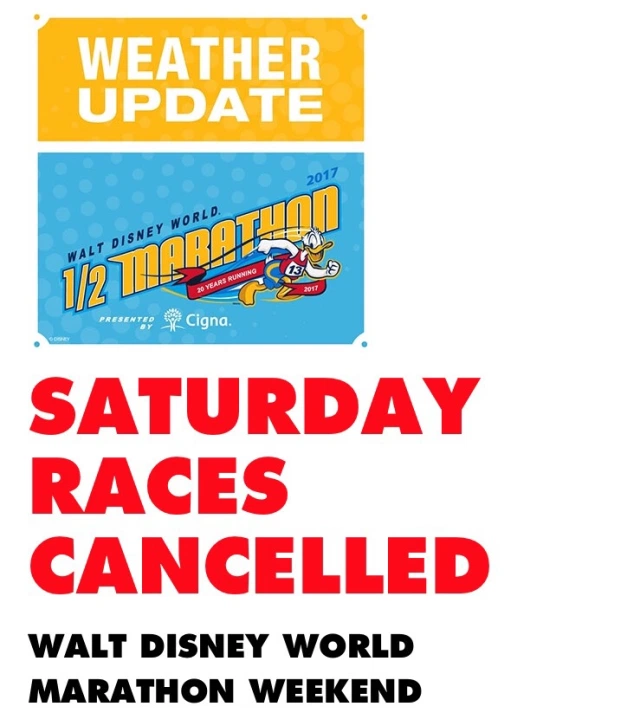
Most Memorable Race: Bib #4 – Walt Disney World Dopey Challenge Half Marathon – If the Black Canyon 100k was memorable because it was miserable, the Disney Half was memorable because, well, it wasn’t. With less than 12 hours before race time and severe lightening in the forecast, race directors canceled the event. Undeterred, thousands took to the streets and resort areas around Orlando to run their own 13.1 mile “races,” many donning their race bibs to do so. Spectators came out, unofficial aid stations popped up, and lifelong friendships were made. At the time, I wasn’t sure if this race “counted.” With the benefit of hindsight, I can say affirmatively – it counts.
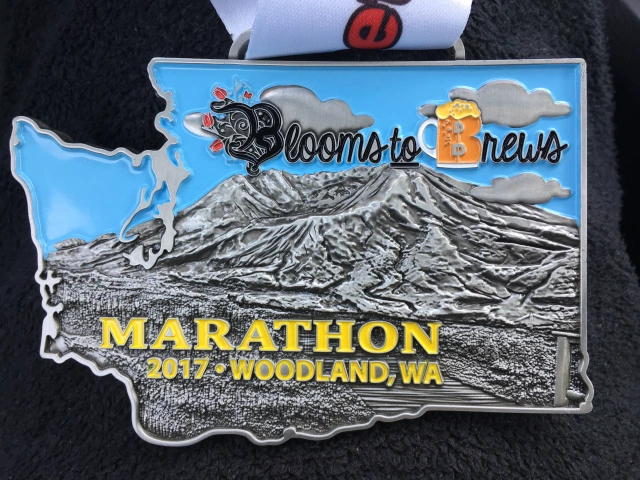
Nearest Miss: Bib #18 – Blooms to Brews Marathon – Running one or two races per weekend means my year has been more about quantity than quality. At mile 13 of the Blooms to Brews Marathon, however, I found myself on marathon personal record pace. At mile 15.5 I decided to take a run at my own record, set at the 2016 Chicago Marathon. I came up just 20 seconds short. Not bad for the 5th marathon of the year, and the day after a trail half marathon with 4,000 feet of gain.
So what’s on tap for the next 20? In just 7 days I will embark on my longest race of the year, the Badwater Salton Sea 81 miler. And I have my sites on my 40th bib — the Runner’s World Half Marathon on October 22, a race I will be running for the 6th consecutive year. I don’t know what will happen between now and then, any more than I could have predicted what was going to happen during the first 40 races. I do know I look forward to continuing to share this journey with everyone who has followed along so far, and am truly grateful for all the support!
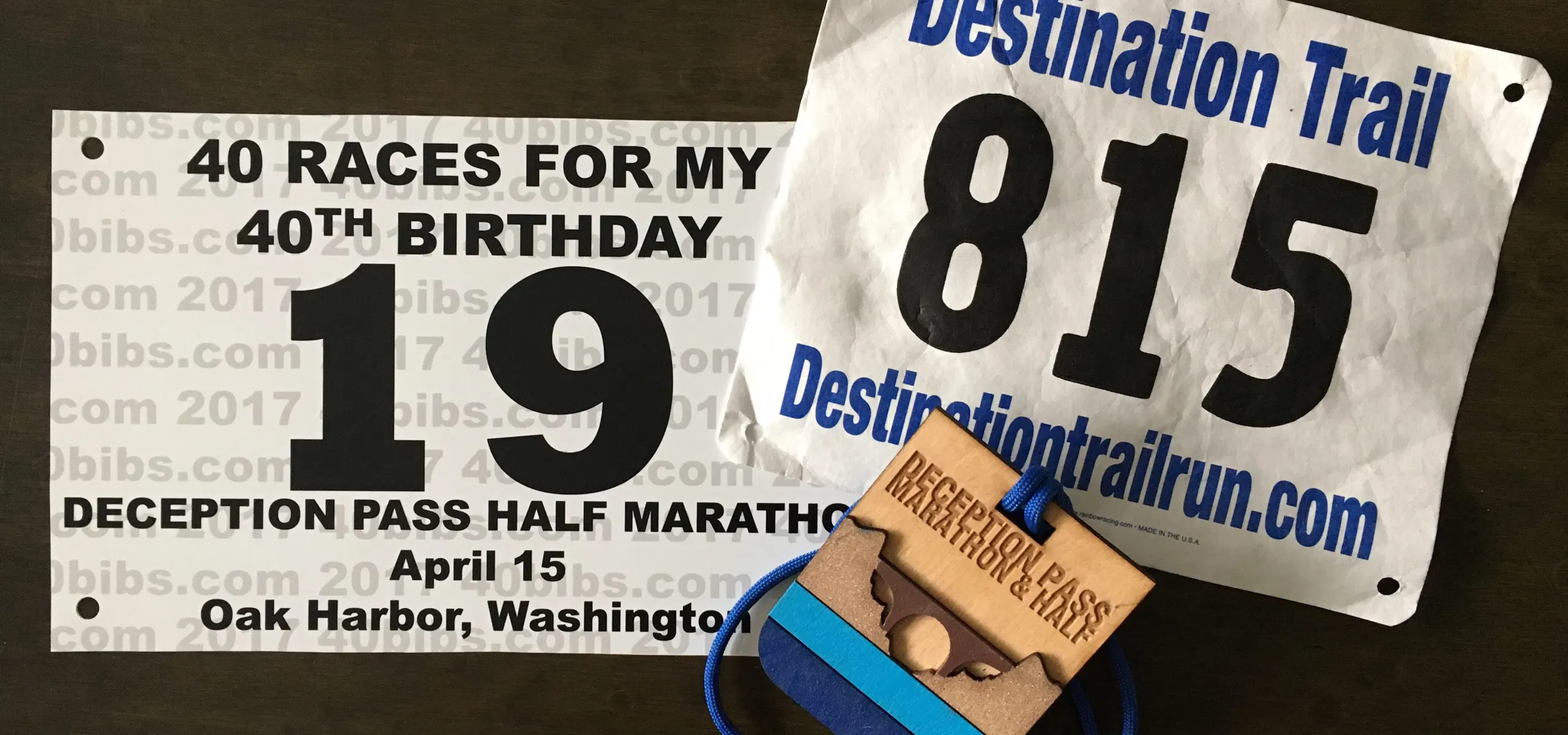
The word “glorious” has always had a religious connotation for me, likely the result of many hours spent in Catholic church as a child. As an adult, the concept of “church” has a more liberal definition. (For example, posting a Facebook photo of my husband and I from our seats behind the Mariner’s dugout on Sunday and captioning it, Happy Easter – from our church to yours.) But “glorious” is still reserved for something bigger than myself and those around me.
And trail scenery.

My shadow, the only blemish on the dunes of West Beach, the race’s start/finish line.
The Deception Pass Marathon & Half was held in Deception Pass State Park, named for the straight separating Whidbey Island from Fidalgo Island. The Pass gets more than 2 million visitors a year, despite its remote, northwest Washington location, nearly two hours from Seattle.
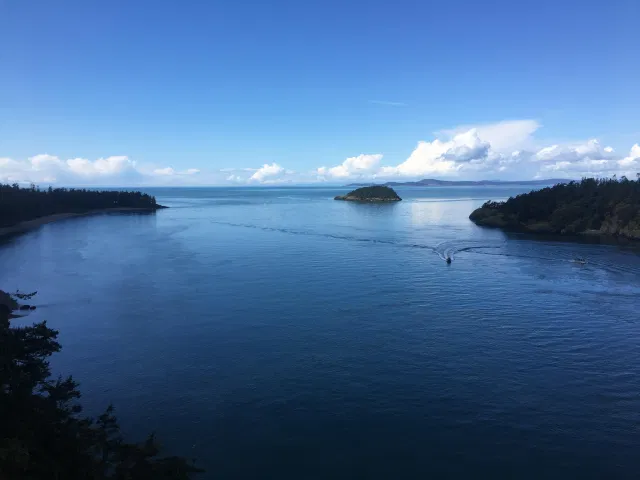
The view from Deception Pass Bridge, a pair of bridges connecting the various islands within the park. Racers crossed the bridge twice.
This is why.

Temperatures remained in the 50s for the entirety of the race, the only clue that we were in Washington, and not on a tropical island.
The race provided amazing views of just some of over 100,000 feet of saltwater and freshwater coastline from beside, and above the race course.

With 2900 feet of climb in the half marathon, racers earned their views.

Racers around the 8 mile mark, still enjoying the views.
Not simply a race, this was a near-religious experience.
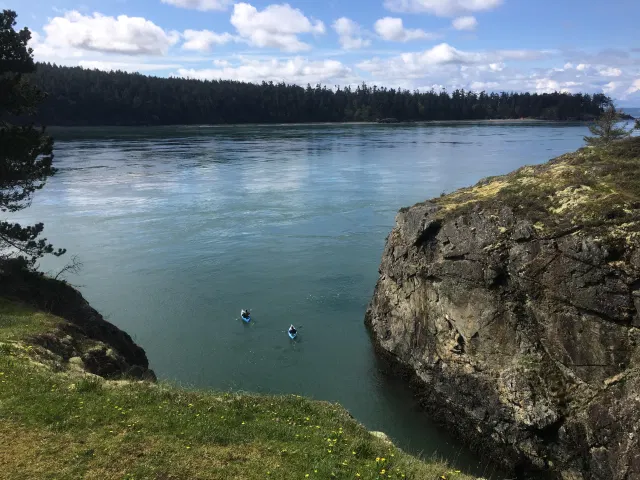
Kayakers emerge from one of the narrow coves, visible just steps from the edge of the running trail.

